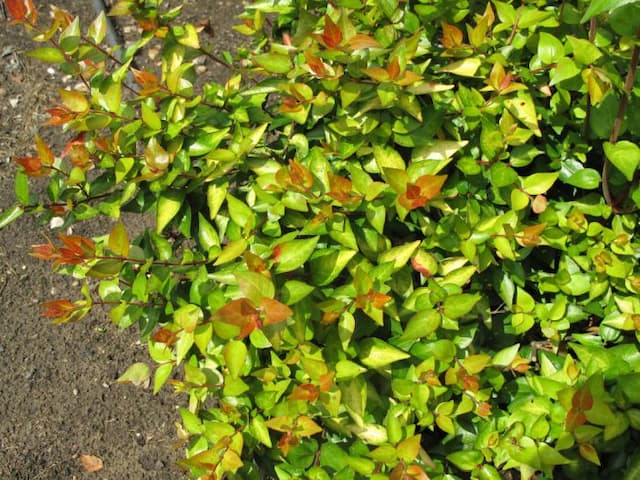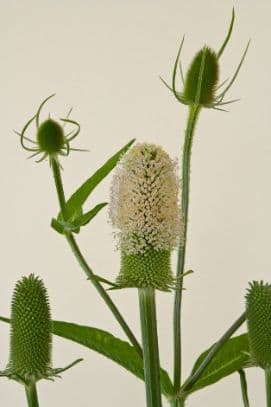Teasel Dipsacus inermis
ABOUT
The plant known commonly as the unarmed teasel, is characterized by a basal rosette of leaves that are lance-shaped, creating a spiky and rugged appearance. As it matures, the leaves may develop a slightly bluish-green hue and present a rough texture to the touch. This formation of leaves may give the plant a somewhat formidable aspect due to their sharp appearance. The unarmed teasel produces flowers that typically bloom in small, dense, egg-shaped heads. These flower heads can appear as a cluster at the top of the plant, surrounded by smaller bract-like leaves which may be spiny. The color of the flowers can range from white to pale pink or lavender, and they are usually seen bunched tightly together, giving the plant a visually unique and somewhat spiky inflorescence. After flowering, the plant develops seed heads that are hard and can be quite detailed in their texture. The seeds can possess pointy ends, which may contribute to the plant's overall prickly visual presentation. Structurally, the stems of the unarmed teasel are straight and sturdy, often appearing a bit ridged with longitudinal grooves. While the stem's color can be a greenish to straw-tinted hue, it often stands out against the foliage due to its firm and solid nature. Despite its daunting name and appearance, the unarmed teasel carries a certain architectural quality, with a distinctive form that can provide visual interest in a garden setting, albeit with a somewhat untamed and wild aspect. Its presence can convey a strong statement with its spiky leaf formations and unique flower heads, attracting those who appreciate a plant with both strong features and delicate floral components.
About this plant
 Names
NamesFamily
Dipsacaceae
Synonyms
Thornless Teasel, Poor-man's Teasel
Common names
Dipsacus inermis.
 Toxicity
ToxicityTo humans
The plant Dipsacus inermis, commonly known as Fuller's teasel, is not widely known for its toxicity to humans. There is limited information about its poisonous nature and specific symptoms of poisoning upon ingestion. However, it is always advisable to use caution and avoid eating plants that are not confirmed to be safe for consumption to prevent potential adverse reactions.
To pets
The plant Dipsacus inermis, known as Fuller's teasel, does not have a well-documented profile for toxicity in pets. There is scarce evidence concerning its poisonous effects or specific symptoms if ingested by animals. Pet owners should exercise caution and prevent pets from consuming parts of plants that have not been clearly identified as non-toxic.
 Characteristics
CharacteristicsLife cycle
Perennials
Foliage type
Deciduous
Color of leaves
Green
Height
4-5 feet (1.2-1.5 meters)
Spread
2-3 feet (0.6-0.9 meters)
Plant type
Herb
Hardiness zones
Varies
Native area
Europe
Benefits
 General Benefits
General Benefits- Wildlife Habitat: Provides a natural habitat for various insects and small mammals.
- Ornamental Value: Adds aesthetic value to gardens with its distinctive spiny flower heads.
- Ecosystem Diversity: Contributes to biodiversity by supporting native flora and fauna.
- Soil Stabilization: Helps prevent soil erosion with its root system.
- Biological Control: Sometimes used in integrated pest management by providing habitat for predator insects.
- Education and Research: Can be used in educational settings to teach about ecology and plant biology.
- Cultural Significance: May have historical or cultural importance in certain regions.
 Medical Properties
Medical PropertiesThis plant is not used for medical purposes.
 Air-purifying Qualities
Air-purifying QualitiesThis plant is not specifically known for air purifying qualities.
 Other Uses
Other Uses- Teasel (Dipsacus inermis) seeds are a favorite food source for birds such as the European Goldfinch; gardeners often grow it to attract these birds.
- The dried flower heads of Teasel were historically used in textile processing to raise the nap on fabrics.
- Teasel can be used in floral arrangements, particularly dried flower arrangements, due to its unique and structural flower heads.
- Water collected from the cup-like formation where the leaves join the stem is sometimes used by florists to provide a natural source of water in floral displays.
- The tall, stiff stems of Teasel can be used as natural stakes in the garden for supporting other plants.
- Artists and craftsmen use the spiky heads of Teasel in creating natural sculptures and decorative pieces.
- In some regions, Teasel is used as an ornamental plant in landscaping for its distinctive appearance and ability to attract wildlife.
- The spiky heads of Teasel have been used as a natural form of pest control to deter animals from entering gardens.
- Teasel can function as a natural dye plant, producing colors such as soft greens and yellows for textiles.
- Ecologically, Teasel provides habitat and winter food for insects, offering a benefit to local biodiversity in the area where it's planted.
Interesting Facts
 Feng Shui
Feng ShuiThe plant Dipsacus inermis is not used in Feng Shui practice.
 Zodiac Sign Compitability
Zodiac Sign CompitabilityThe plant Dipsacus inermis is not used in astrology practice.
 Plant Symbolism
Plant Symbolism- Protection - The spiny nature of fuller's teasel's burs is often associated with protection and defense against negative forces.
- Cleansing - Historically used in the wool industry to raise the nap on fabrics, fuller's teasel symbolizes the act of cleansing and purification.
- Resilience - Fuller's teasel can grow in tough conditions and symbolizes resilience and the ability to thrive in challenging environments.
- Persistence - The plant's tendency to hold onto its seeds until the right conditions occur symbolizes persistence and patience.
- Order - Its geometric, spiny flower heads are associated with organization and order, reflecting its historical use in textile processing.
 Water
WaterThe common name for Dipsacus inermis is Fuller's Teasel. When watering Fuller's Teasel, provide deep watering to encourage root development, typically once a week during the growing season. During hot, dry periods, increase the frequency to every few days, as the soil should not be allowed to dry out completely. In terms of quantity, around 1-2 gallons per week for an established plant will suffice, adjusting for size and environmental conditions. Overwintering plants may require less water, depending on the climate and rainfall.
 Light
LightFuller's Teasel thrives in full sun to partial shade conditions. The best spot for planting Fuller's Teasel is in an area where it receives at least 6 hours of direct sunlight a day. However, in exceedingly hot climates, some afternoon shade can be beneficial.
 Temperature
TemperatureFuller's Teasel grows best in a temperature range from 60 to 75 degrees Fahrenheit. It can tolerate minimum temperatures down to about 20 degrees Fahrenheit and maximum temperatures as high as 90 degrees Fahrenheit. However, performance is optimal when temperatures are kept within the ideal range.
 Pruning
PruningFuller's Teasel should be pruned to remove spent flower heads and to maintain plant size and shape. The best time to prune the plant is in late winter or early spring before new growth begins. Pruning every year encourages healthy growth and prevents the plants from self-seeding excessively.
 Cleaning
CleaningAs needed
 Soil
SoilFull teasel, or Dipsacus inermis, prefers well-drained soil with a pH range of 6.0 to 7.5. A mix of loam, peat, and sand in equal parts can create an ideal environment for this plant, allowing for proper drainage and root development. Regular organic matter enrichment will help maintain soil health for the full teasel's growth requirements.
 Repotting
RepottingFull teasel (Dipsacus inermis) usually does not require frequent repotting due to its biennial nature, often completing its life cycle in two years. Repotting can be done if the plant seems to be outgrowing its current pot or if the soil has depleted, typically every 2-3 years to replenish nutrients.
 Humidity & Misting
Humidity & MistingFull teasel (Dipsacus inermis) is adaptable to a wide range of humidity conditions and does not require high humidity. It thrives in outdoor settings where the humidity levels are natural and does not necessitate specific humidity adjustments when grown indoors.
 Suitable locations
Suitable locationsIndoor
Place in bright light, ensure good air circulation.
Outdoor
Plant in full sun, protect from strong winds.
 Life cycle
Life cycleDipsacus inermis, commonly known as the toothless teasel, goes through several distinct stages in its life cycle. The plant begins as a seed, often lying dormant in the soil until conditions are favorable for germination, which requires a well-draining soil and some degree of sunlight. Upon germination, the seedling emerges, developing a rosette of foliage close to the ground in its first year. In the second year, the toothless teasel progresses to the vegetative stage where it forms a stem and begins to grow upwards, eventually producing tall flower spikes. These flower spikes are composed of small flowers that, once pollinated by insects such as bees, develop into seeds. The plant completes its life cycle when these seeds mature and are dispersed, either by wind or through contact with animals, before the parent plant dies, being a biennial species.
 Propogation
PropogationPropogation time
Spring to Summer
The common name for Dipsacus inermis is Teasel. The most popular method of propagation for Teasel is by seed. Seeds should be sown directly into the garden in fall, as they require a period of cold stratification to break dormancy. Alternatively, if you're starting seeds indoors, simulate this cold period by placing the seeds in moist sand within a plastic bag, and refrigerate for about two to four weeks before sowing at a depth of about 1/4 inch (6 mm). Keep the soil evenly moist until germination, which typically occurs in two to three weeks. Once seedlings have grown large enough to handle, typically when they have at least a couple of true leaves, they should be transplanted to their permanent positions in the garden, spaced approximately 24 inches (61 cm) apart to allow for mature growth.









